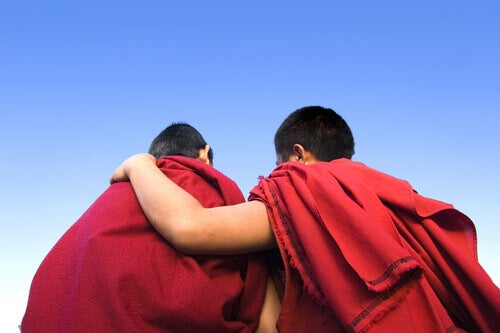Herbert Benson, a cardiologist and famous professor of medicine at Harvard University, spent years studying Eastern cultures in the 1960s, at that time some people were still preoccupied with the subject. So he waited until after midnight to infiltrate 36 Tibetan monks into his laboratory.
Benson wanted to see for himself how much myth and how much reality there was in what was said about Tibetan monks. At the time, Bruce Lee was a popular figure, but transcendental meditators were considered people with superhuman characteristics. Benson was a scientist, and I didn’t believe anything that science proved.
- What he discovered that night changed his life forever.
- Three years later.
- He wrote a book that later became a bestseller: The Relaxation Answer.
- Not only that.
- But he created a type of alternative medicine.
- Which states that faith is capable of healing and healing.
- That the placebo effect has a very high therapeutic power.
“The target world is only half the universe, isn’t that what we perceive through our senses the world as a whole?. – Swami Rama-
What Herbert Benson and his team discovered was that Tibetan monks actually had skills that contradicted scientific claims.
For example, a group of monks who practiced yoga using a technique called g Tum-mo could reduce the temperature of their hands and feet by up to 17 degrees. So far, there is no scientific explanation for this phenomenon, but the Harvard Gazette did analyze this experiment and other subsequent experiments.
Tibetan monks are supposed to raise their body temperature to the point of drying wet sheets with the body, but this was not the only discovery. Benson also found that advanced meditators using another technique called Sikkim could also slow down their metabolism by up to 64%.
The article Science and Meditation, by Professor Ana María Krohne of Antonio Nariño University, states that to date there are around 500 studies on the physiological, psychological and sociological effects of transcendental meditation inspired by the traditions of Tibetan monks.
He also mentions that the first study on this subject was published in the journal Science in the 1970s, in this, the author indicates that a different state of consciousness was found in monks.
Science speaks of states of consciousness of wakefulness, sleep and deep sleep. Apparently, among the monks, there was a fourth state that simultaneously combined rest and alertness.
In 1971, Daniel Goleman, creator of the concept of multiple intelligences, wrote an article entitled “De-stressing”, postulating the existence of a fifth type of state of consciousness in which there is not only simultaneous rest and alertness, but also action.
The question of the superior abilities of Tibetan monks and other transcendent meditators is one of those issues that always walk in a thin line between fiction and reality, so it is not uncommon to find verified information as well as many myths and legends. , it is not always easy to distinguish from each other.
An example of this is the case of Swami Rama, author of Living with the Masters of the Himalayas, who in this book states that there are Tibetan yogis and monks capable of standing still for several hours and levitating.
However, there is no evidence that this is true, but there are studies that the Menninger Foundation in the United States has conducted using it as a volunteer.
Dr. Elmer and Dr. Alyce Green studied their supposed powers. His results indicated that Rama was able to produce the same sleep brain waves in his wakefulness. In addition, he had managed to voluntarily stop the heartbeat for 17 seconds without him stopping beating.
Although these phenomena were published in the media at the time, little was said about them after, in any case, the results of the studies were published in Beyond Biofeedback by Elmer and Alyce Green.
Perhaps all this is nothing more than a sophisticated and ingenious farce, or maybe the spirit is absolutely wonderful and we are just beginning to discover it.

